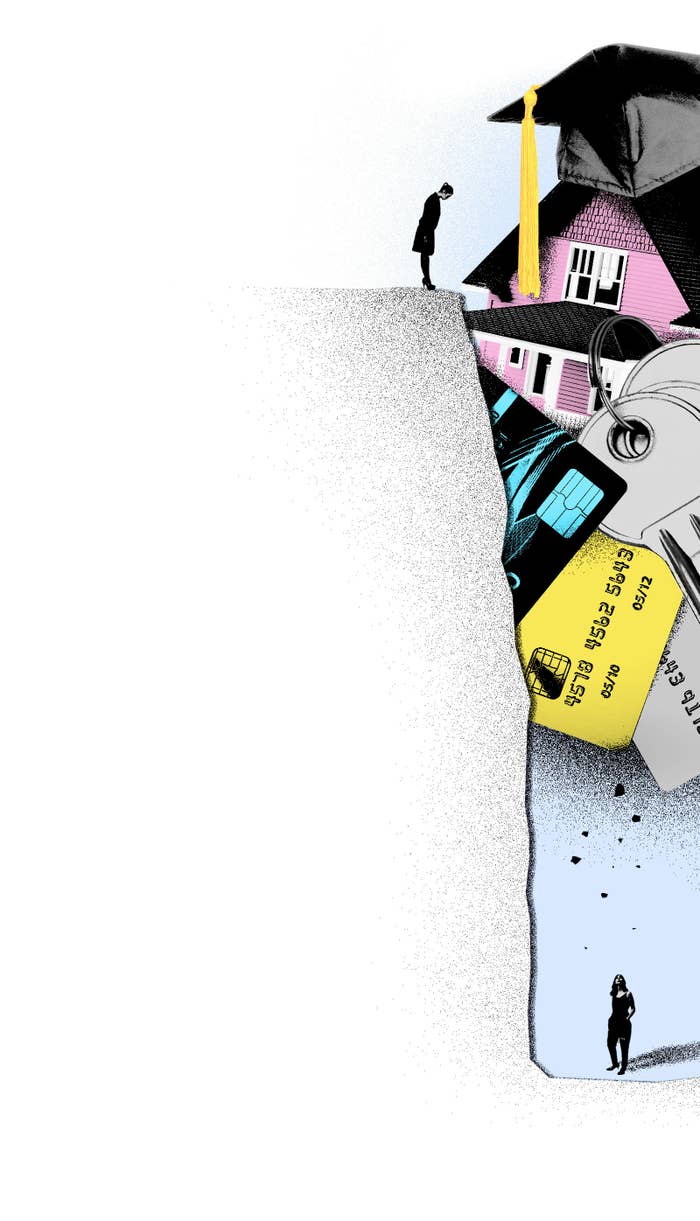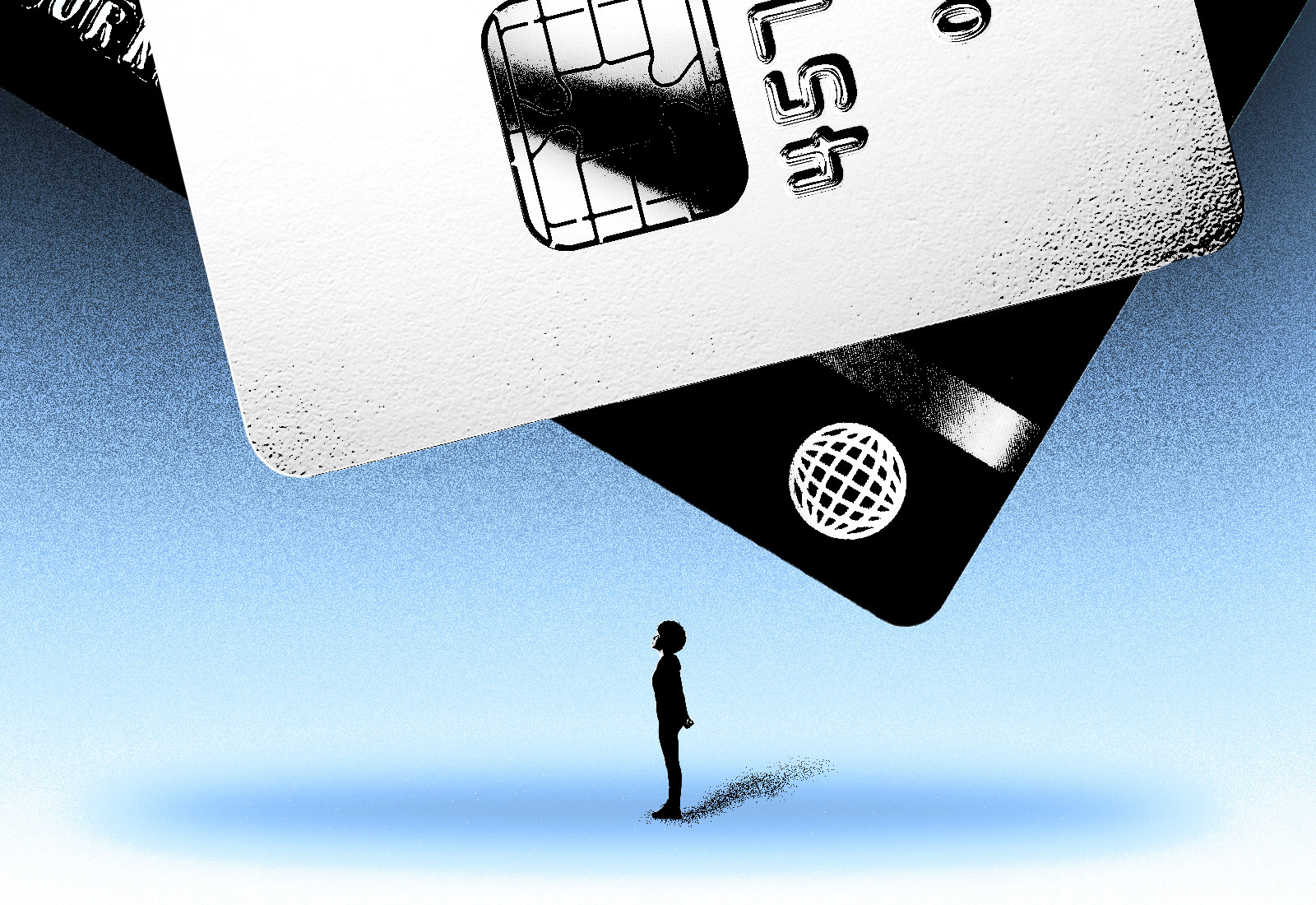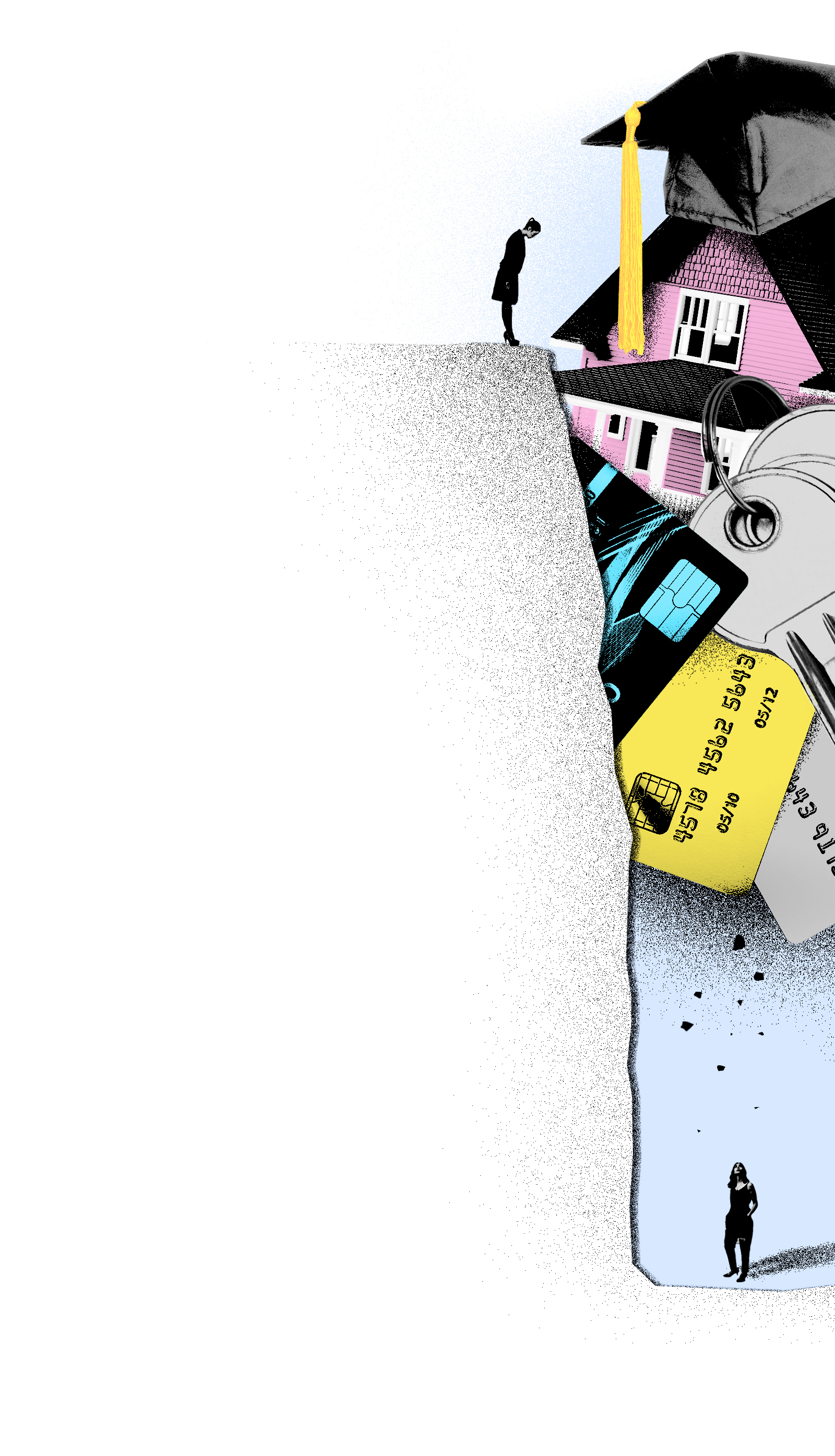
By late May, more than two months after losing work as an aircraft mechanic, James still had yet to receive any response from Georgia’s Labor Department about his unemployment benefits. The nearly $4,000 he had in savings, which he had expected would stretch a few months longer, were gone by then, forcing him to take out a $2,500 personal loan from his bank. With no paycheck, that too ran out with time. As a young adult trying to pay his way through college, James had few options.
It wasn’t long before he began putting his rent, groceries, and gas on his credit card. First hundreds of dollars, then thousands, not even counting the interest. His old employer called him in for occasional mechanic work but too infrequently for him to depend on those wages for a living. Winter arrived. No unemployment check ever came. Some days, thinking about money and debt keeps James in bed well past the morning — his “safe place.”
“A lot of people make it sound like you should have that rainy day account — but that goes fast,” said James, who asked only to be identified by his first name to protect his privacy. “Being a college student, it’s not easy to have a very big savings account, especially when you're paying for everything yourself and you don't have parental support.”
James’s financial pressures are only growing heavier.
A far greater debt will come due after James graduates in May: his student loans. He will set foot, a young Black man of 23 years, into the blight of a ruthless pandemic, with no savings and thousands of dollars of debt weighing heavily on his shoulders. He will have borrowed about $32,000 for his four-year degree in engineering, nearly two years of which were conducted remotely. He will owe hundreds in monthly student loan payments, on top of what he will owe for the additional debts he took on to make it to graduation.
“Sometimes it's paralyzing. Like, congratulations, I can pay my rent and eat today. But I'm going to have to pay all of this back in some way or another,” he said. To push through overwhelming moments like these, James recalls some unrelated advice his supervisor once gave him about running, “‘If you ever get tired, just keep falling forward and your feet will just keep catching you,’” he said. “That's where I'm at at this point.”
Debt drives the American economy: Household debt was about 75% of GDP before the pandemic and close to 100% during the Great Recession. Millions of people risk huge amounts in pursuit of a middle-class standard of living. They borrowed to survive or to get ahead, they saved what little they could, and if they couldn’t pay, they were dealt harsh consequences in the form of interest fees, repossessions, and foreclosures. Households with loans have about $145,000 in debt on average, and the average monthly debt payment was $1,233 in early 2020. Yet upward mobility comes with risks, and accumulating debt for that goal puts people in a precarious financial position. What little margin for error they may have had in the best of circumstances was eliminated by the pandemic. The crisis lays bare the reality that many people are unable to withstand an unforeseen setback.
Many others like James who took on college loans to secure what they believed was a path to upward mobility will enter professional life facing dire financial conditions, on the precipice of spiraling into a cycle of missed payments. Over 14 million people are behind on their rent, 27 million people are on student loan forbearance or deferral, 2.7 million homeowners pay less than their full monthly mortgage cost, and about 5% of auto loans are delinquent. Their futures are now left in the hands of the lenders and lawmakers who decide what bills to delay, forgive, or cover — if at all. A patchwork of laws has granted people with housing and student loan debts only incremental relief that they have no chance of paying back without an economic turnaround or more government assistance. No regulatory protections exist for people with credit card debt, auto loans, and payday loans, putting their fates at the mercy of their creditors.
James had hoped his college education would help him escape the financial stress he saw around him as a child, when his family sometimes had to live in motels. “Growing up, I went through so much, and I saw so much, that after a while I just learned to compartmentalize,” James said. “I just had to learn: Sometimes shit happens, and you want to scream and freak out in the moment, but you’ve just gotta keep pushing. It definitely sucks, but it's kept me alive this far.”
Resilience alone isn’t enough. By the end of January, despite his best efforts, he was a month late on rent, $600 behind on his car note, and owed $200 for overdue cellphone bills, not to mention the rising credit card debt. Emergency relief funds briefly helped him pay this down but didn’t change his fundamental circumstances.
“It all built up very quickly,” he said.

Josh was the first in his family to graduate from college. He was raised in Southern California by his mother, a third-generation American whose family came from Mexico. “I was not just the first in my family to go to college, but to go to one of the top five schools in the country,” said Josh, who enrolled at Columbia University about a decade ago. It wasn’t clear how he would pay for it, but “there was an expectation that I would go, that you don't just throw something like that away.” So, like many, he filled out a FAFSA, or financial aid application, to see how much aid he could get.
As the cost of tuition around the country skyrockets, it’s hard not to feel that higher education has become a rich person's game that everyone else keeps trying to participate in. Nearly 60% of undergrads take out a student loan — so they have a chance to compete in the economy. And the amount borrowed for a bachelor's degree, over the years, has increased to $29,000 per borrower, according to the College Board, and it’s not just because of expensive private schools. Public colleges may have a lower sticker price but may also offer less financial aid. Graduates of public universities with loans borrow nearly $27,200 on average. Many of these students are assuming this massive financial responsibility with limited guidance: About half of undergrads are the first in their family to attend college.
Just as generations of Americans in the postwar years grew up believing that owning a home was central to moving upward, many of those entering adulthood in the postindustrial US believe that a college degree is the only thing protecting them from falling downward. Before the pandemic, roughly 1 in 10 people who didn’t have a bachelor’s degree lived in poverty. Data show over and over again that people who do not hold college degrees have worse health, employment, and other outcomes. So people go to college, including millions who in reality cannot afford to and must borrow.
The school requested Josh’s father’s financials, despite his parents’ divorce 15 years earlier and despite his mother’s repeated attempts to make it clear he would not be contributing to Josh’s education. In the end, she relented and contacted her ex-husband for his financial information to complete the application, even though he did not intend to help pay for school. Josh chalked it up to “my mother's lack of savvy with dealing with financial aid applications.” This process is a dive into the unknown for many people.
Colleges don’t necessarily determine how much financial aid students are granted based on need alone. “Merit aid” often goes to applicants from families with high incomes, “even in the 1%,” in order to attract students who can pay more out of pocket, as Ron Lieber reported in his book The Price You Pay for College. “This raises some obvious questions about equity, for what merit aid really does is ‘aid’ the family that may be able to afford the sticker price but isn’t sure that it’s willing to pay,” he wrote. It leaves those with fewer resources to borrow more. There is no minimum income requirement to get federal student loans, and students can borrow up to $57,500 for undergrad and $138,500 for grad school, without any clear sense of how much they will be earning when they graduate.
In a statement to BuzzFeed News, Columbia said it reviews submitted requests to waive the two-parent requirement and “provides admitted students the opportunity to review and discuss their financial aid eligibility before making the decision to matriculate at Columbia rather than another college.”
Columbia offered Josh more aid than any of California’s state schools, but it still expected his family to contribute $10,000 out of pocket each year — money they did not have. His mother’s poor credit disqualified them from getting private loans. So Josh resolved to somehow find a way to make it work once he got there.
But the reality of making ends meet once he arrived in New York City was harsher than he had imagined as an 18-year-old. "There were literally just thousands of dollars between me and having a place to live and learn the next six months,” said Josh, who asked to remain anonymous. He felt forced into making a tough choice for money.
Around October of his first year in college, Josh started doing sex work, opening an account on Rentboy.com, a site where people can offer services that was later shut down by federal investigators in 2015 for advertising prostitution. The idea hatched from a comment someone had casually made to Josh as a teen after a hookup — that he was really good-looking and “could make money doing this.”
“It didn’t occur to me that I would ever have to until my situation came about,” said Josh, which is the alias he used as a sex worker. “I made an account there. And pretty quickly, I got pretty popular.”
On a normal week, he had three clients. On his busiest week, he had 10. Josh earned a few hundred to $2,000 per week depending on what kind of sessions were requested. But he worked only until he’d made enough to pay the school, and no more. “There were times where I felt I feared for my life. I feared for my future — for my name being out there associated with what I did. I feared for what that would mean for my family. I feared being found out. I feared for just my own material safety,” Josh said. “I think there's an attitude today that sex work is just another form of work. And for those who can engage with it like that, I respect them, all the power to them,” he said. But he described his own experience as traumatizing. He said he became “emotionally numb” and was having irrational outbursts and night terrors. He was later diagnosed with PTSD.
In the summer before his junior year, Josh was no longer able to handle the situation he was in. He requested a meeting with a financial aid officer and told his story before demanding more financial aid. They told him they would take it to the board, but couldn't promise anything. “I don’t think there was anything really to be said, just mutual recognition of the system’s failure,” Josh said. “Institutions and systems don't have empathy.”
Soon after, Columbia granted Josh the aid he needed to stop doing sex work. It came via a brief email with revised figures that no longer took his father’s income into account. Just like that. “The precariousness of my existence was hinged on a few thousand dollars that Columbia didn’t really need,” he said. “I felt betrayed by an institution that had said we’re an equitable place, that we want all people of all different backgrounds to come here and succeed,” he said, looking back on his time in the Ivy League.
These days, Josh, now in his mid-20s, thinks back about college and his expectations with a fresh clarity: “Colleges do a lot to promise people upward mobility. They do a lot to promise brighter futures, leading the world and the next generation of leaders, and such and such,” he said. “For me, an illusion was maintained by my teachers, my mom to a degree, and society as a whole. It said, ‘Hey, look, come to this magical thing called college. It’s a fantasy world that will give you the capacity to be anything you want to be.’ ... I saw that as my ladder up in the world. And when I got there, it was like, OK, turn off the illusion. Here’s reality, and you have to make this [money] up somehow.”
Josh continues to pay for his education at Columbia today; he’d taken out nearly $30,000 in student loans, which has worked out to a payment of roughly $250 per month. A portion of that total is administered by Columbia itself, which ignored Josh’s request for forbearance when the pandemic began.
Unlike other loans — such as mortgages, which give you a place to live; car loans, which give you a vehicle to drive; credit cards, which can pay for essential things you need to survive — students loans guarantee only a diploma, nothing more, leaving a borrower to gamble thousands of dollars and a future of debt in hopes of winning a career that earns them enough to pay off that debt. As of 2019, 3.3 million college graduates were living in poverty.
According to a 2019 report by the Federal Reserve Bank of St. Louis, the wealth impact of having or not having a bachelor’s degree is “statistically indistinguishable from zero” for nonwhite graduates and “at a historic low” for white graduates. Two possible reasons the researchers cited for the declining financial value of college are rising consumer debt and the price of college. “Our results suggest that college and postgraduate education may be failing some recent graduates as a financial investment,” they wrote.
The pandemic has made the uncertain fate of indebted college grads even more pronounced. In January the unemployment rate for people ages 20 to 24 was 9.7%.
James, the 23-year-old graduate in Georgia, hopes to avoid this fate. He recently received a job offer to make missiles, and he’s waiting to hear back from NASA, a dream job since his boyhood love of spaceships and planes. From afar, James was an example of the education system working: the child of a household with a lower income who borrowed money to go to school, worked hard, and got a good job. Yet a closer look shows anything but an ideal path.
“You’re making an investment on a prayer,” said James. “You understand what you're getting into. You just don't have another choice.”
For Josh, who now works for a nonprofit in California, the question of whether the debts he took on were worth the price hangs over his every decision and setback. “In terms of who I am as a person, that's an unanswerable question,” he said of the value of going to college. The financial measure was more clear to him: “In terms of my income, I’m probably making about what I would have made if I hadn't gone to college.”

SR, a Black 26-year-old graduate of New York University, said she came from a “very low-income family” in California. She was the first woman in her family to earn a bachelor’s degree and is now working as a middle school music teacher, just like she dreamed.
This came at no small cost. NYU offered her aid and merit scholarships, but her family was still expected to pay for room and board out of pocket, despite SR’s mother earning just $22,000 to support four children the year SR graduated from high school. Still, NYU brought her family’s expected contribution lower than California’s state schools, and so she moved across the country. At the end of her four years, she had borrowed $53,600. NYU did not respond to a request for comment from BuzzFeed News.
SR’s teaching salary was about $51,000 before taxes, though, and she needed a way to pay her $500 student loan bill each month, so she’s continued to work as a server well after graduating. “I did not expect that, after graduating college, I was still going to be working multiple jobs,” she said.
While student debt is almost a given for the upwardly mobile, some borrowers fall into low-wage jobs anyway, because of the very debt that they hoped would be their ticket to somewhere better.
SR, who asked not to be identified by her full name, typically worked 24 to 36 hours a week at the restaurant — classes ended at 2:40 p.m.; she would teach choir until 3:30 p.m., then hop on the subway, and have about 30 minutes to change, put on some makeup, and eat before her 4:30 p.m. shift. She’d sleep for about five to six hours before starting it all over again the next day.
As hard as that was, it got worse when the pandemic hit. SR lost her job at the restaurant, and she put her student loans on forbearance. Her credit card debt rose from $0 to $11,000, due to taxes owed to the IRS and tuition for grad school courses she needs to move into a higher pay band. New York’s persistent housing affordability crisis hasn’t helped.
SR rents an apartment with a roommate in Manhattan’s Financial District, midway between the school and the restaurant. Her share of the rent is $1,900. There are lower-cost areas in New York, but this was convenient to both of her jobs, which was especially important when she worked a late shift at the restaurant. SR sleeps in a space carved out of the living room with a large Ikea wardrobe. If she didn’t have student loans, about one-sixth of her take-home pay now, SR thinks, “I could probably have a real room with doors.”
She wishes she had understood how her debt would affect her future. But like James, Josh, and many other first-gen college kids who reached out to BuzzFeed News, her family had no experience navigating the complexities of financing an education.
Some family friends told SR, “Don’t borrow more than your salary” — tough advice to follow when you don’t know what kind of work you’ll be doing, what the job market will be like when you graduate, and whether you can actually get a job in your field.
Other family friends, including parents on the swim team her mom coached at the racquet club, told her, “Don’t let the money decide where you go. Go where you want.” Only in hindsight did SR realize that the people giving her this advice had vastly different financial resources: Their wealth gave them the confidence to believe paying back loans is not something to be concerned about. “It was a lot of those families who had no issue sending their kids to college, with two parents that were college graduates, who had beautiful homes in gated communities with a lake or a golf course telling me, ‘Don't worry about the money. Go to school. You’ll be fine after.’”
None of that occurred to her as a teen. And anyway, who was she to challenge the wisdom of people who were doing so well, who seemed to have figured it out?
With renewed calls on Congress to pass a student loan forgiveness bill, the pandemic could be a meaningful turning point. Not only are lawmakers considering Biden’s plans to cancel student debt, but prospective students are also weighing the value of borrowing large sums of money to attend school remotely during the pandemic. And at least some young people have already decided that college isn’t the best path to financial stability.
Bethany, a 30-year-old from Texas, borrowed more than $90,000 in federal and private student loans to attend a public university, her older sister graduated with $120,000 owed, and their father, who graduated when he was 38, still has $30,000 left to cover on his own college loans. Bethany’s $984 monthly bill, with interest rates that rose above 7%, became ever harder to pay when she was laid off from her job in November, amid pandemic budget cuts.
Her younger brother, who is 24, viewed their struggles as cautionary tales, she said. He decided to avoid the risk of going to college and instead sought to move ahead by bartending, starting his own business ventures, and flipping houses. “His whole thing,” Bethany said, "and it breaks my heart every time he mentions it: His goal in life is to make enough money that he pays off all of my debt, my sister’s debt, and my parents’ debt.” ●

